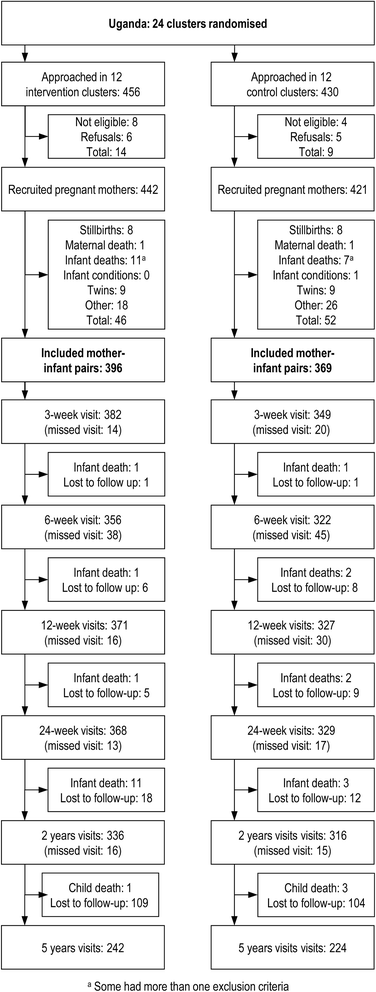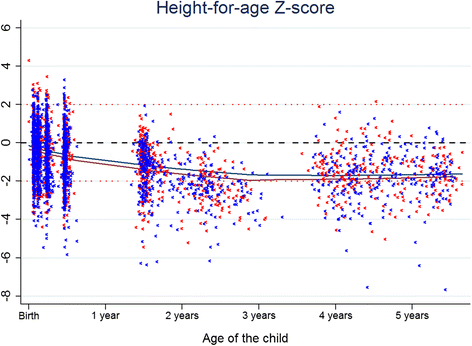Effects of an exclusive breastfeeding intervention for six months on growth patterns of 4-5 year old children in Uganda: the cluster-randomised PROMISE EBF trial
- PMID: 27405396
- PMCID: PMC4942943
- DOI: 10.1186/s12889-016-3234-3
Effects of an exclusive breastfeeding intervention for six months on growth patterns of 4-5 year old children in Uganda: the cluster-randomised PROMISE EBF trial
Abstract
Background: Breastfeeding promotion is regarded as one of the most effective interventions to improve child health, and could reduce under-5-mortality by 8 % globally. Few studies have assessed the health outcomes beyond infancy of interventions promoting exclusive breastfeeding.
Methods: This study assessed growth in under-five children who participated in a cluster-randomised trial in Eastern Uganda (ClinicalTrials.gov.no.NCT00397150). In the intervention arm, peer counsellors promoted exclusive breastfeeding during the first 6 months of infancy. There were no interventions after 6 months of age. Mother-infant pairs were interviewed at visits scheduled at 3, 6, 12 and 24 weeks after birth and follow-up visits at 2 and 5 years, with 765 included in the analyses.
Results: The mean length/height-for-age and weight-for-age-z-score (HAZ, WAZ) decreased with increasing age in both the intervention and control arms. At the three weeks visit, HAZ in the intervention was -0.45 (-0.68;-0.21) and -0.32 (-0.56;-0.07) in the control arm. At the 2 year follow-up, the mean HAZ in the intervention was -1.85 (95 % CI -1.97;-1.73) compared to -1.61 (-1.87;-1.34) in the control. Similarly, at the 5 year follow-up, the mean HAZ in the intervention was -1.78 (-2.08;-1.47) compared to -1.53 (-1.79;-1.28) in the control arm. At the 2 year follow-up visit, 139 (45 %) were stunted (HAZ<-2) in the intervention compared to 109 (37 %) in the control arm, odds ratio (OR) 1.7 (1.1;2.4). Underweight (WAZ<-2) was also more common in the intervention arm than in the control at the five years follow-up (OR 1.7 (1.0;2.8)), with a mean WAZ of -1.28 (-1.47;-1.08) and -1.06 (-1.19;-0.92) in the intervention and control arm, respectively.
Conclusion: While stunting was widespread at 2 and 5 years of age in both arms, it was more common in the intervention arm. It is questionable whether community-based support from lay people with short training and focussing only on exclusive breastfeeding, is an appropriate strategy to improve child health and development.
Trial registration: ClinicalTrials.gov.no. NCT00397150 . Registered 7th of November 2006.
Keywords: Anthropometry; Exclusive breastfeeding; Growth; Peer-counselling; Uganda.
Figures


References
-
- Britton C, McCormick FM, Renfrew MJ, Wade A, King SE. Support for breastfeeding mothers. Cochrane Database Syst Rev. 2007;1:CD001141. - PubMed
-
- Tylleskar T, Jackson D, Meda N, Engebretsen IM, Chopra M, Diallo AH, Doherty T, Ekstrom EC, Fadnes LT, Goga A, et al. Exclusive breastfeeding promotion by peer counsellors in sub-Saharan Africa (PROMISE-EBF): a cluster-randomised trial. Lancet. 2011;378(9789):420–427. doi: 10.1016/S0140-6736(11)60738-1. - DOI - PubMed
Publication types
MeSH terms
Associated data
LinkOut - more resources
Full Text Sources
Other Literature Sources
Medical

